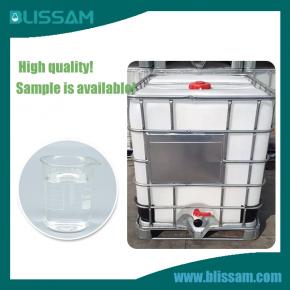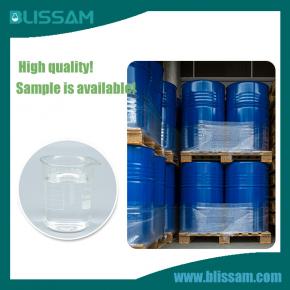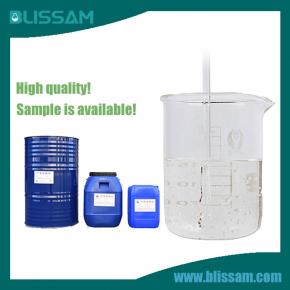We are committed to providing premium quality products at competitive prices, along with excellent customer service. Our state-of-the-art manufacturing facilities and strict quality control processes ensure that we meet the highest standards in the industry. We also have a team of experienced professionals who are dedicated to continuously improving our products and processes to meet the evolving needs of our customers.
We understand the importance of quality in our products and have a strict quality assurance program in place. Our products undergo rigorous testing at every stage of the manufacturing process to ensure consistent quality. We also follow international standards and regulations to ensure the safety and reliability of our products.
BLISSAM takes pride in providing high-quality silicone fluids and exceptional customer service. With our commitment to quality, innovation, and customer satisfaction, we strive to be the preferred choice for silicone fluid solutions. Contact us today to learn more about our products and services.

Introducing our revolutionary line of Silicone Fluids - the perfect solution for all your lubrication and insulation needs. Made from the highest quality silicone, our products offer superior heat resistance, unbeatable insulation, and exceptional durability. With a wide range of viscosities to choose from, our Silicone Fluids are suitable for various applications, making them a versatile choice for any industry. Trust in our Silicone Fluids to provide long-lasting lubrication and protection for your equipment, while creating a barrier against moisture, heat, and other adverse elements. Upgrade your lubrication game with our Silicone Fluids and experience the ultimate in performance and efficiency.
Introducing our premium silicone fluids, perfect for a wide range of applications. Our silicone fluids are carefully formulated to provide superior lubrication, heat resistance, and chemical stability. Whether you're looking for a high-performance lubricant for precision machinery or a long-lasting protectant for outdoor equipment, our silicone fluids are the ideal choice. With their exceptional properties, they can withstand extreme temperatures and harsh environments, ensuring optimal performance and protection. Give your equipment the best with our silicone fluids.

Silicone fluids, also known as silicone oils, are a type of synthetic polymer fluid that is commonly used in various industries due to its unique properties. These fluids are composed mainly of silicon atoms and oxygen atoms, giving them a characteristic flexibility and heat resistance. They are available in a wide range of viscosities, making them suitable for a variety of applications including lubrication, release agents, and coatings. With their low surface tension and non-toxic nature, silicone fluids are also commonly used in the cosmetic and personal care industry. In addition, they are highly stable and have excellent electrical insulation properties, making them suitable for use in electronic devices. Overall, silicone fluids offer a versatile and efficient solution for many different industries and applications.
1.What are the challenges in formulating with silicone fluids and how can they be overcome?
2.What is the role of silicone fluids in the production of adhesives and sealants?
3.What factors influence the viscosity and flow properties of silicone fluids?
4.What are the environmental concerns related to the use of silicone fluids?
5.How do silicone fluids act as a lubricant and why are they preferred in certain applications?
6.What are the potential hazards of using silicone fluids and how can they be minimized?
7.What is silicone fluid and its chemical properties?
8.How does the molecular structure of silicone fluids affect their physical properties?
9.How are silicone fluids used in the production of paints and coatings?
1.What are the challenges in formulating with silicone fluids and how can they be overcome?
1. Compatibility with other ingredients: Silicone fluids can be incompatible with certain ingredients, such as certain types of surfactants and emulsifiers. This can lead to issues with stability and texture of the final product. To overcome this challenge, it is important to carefully select compatible ingredients and conduct compatibility tests before formulating. 2. Emulsification: Silicone fluids are hydrophobic in nature, making them difficult to emulsify in water-based formulations. This can result in separation of the silicone phase from the rest of the formulation. To overcome this challenge, emulsifiers specifically designed for silicone emulsification can be used. 3. Viscosity control: Silicone fluids come in a wide range of viscosities, which can make it challenging to achieve the desired consistency in a formulation. This can be overcome by using a combination of different viscosity silicone fluids or by using thickeners and rheology modifiers. 4. Volatility: Some silicone fluids have a tendency to evaporate, which can affect the stability and performance of the final product. To overcome this, it is important to select silicone fluids with the appropriate volatility for the intended use and to use them in combination with other ingredients that can help reduce evaporation. 5. Sensory properties: Silicone fluids can leave a greasy or heavy feeling on the skin, which may not be desirable for certain formulations. To overcome this, it is important to carefully select the type and amount of silicone fluid used and to balance it with other ingredients to achieve the desired sensory properties. 6. Cost: Silicone fluids can be more expensive compared to other ingredients, which can be a challenge for formulators working with a tight budget. To overcome this, it is important to carefully consider the cost-benefit ratio and to explore alternative ingredients that can provide similar benefits at a lower cost. 7. Regulatory restrictions: Some countries have restrictions on the use of certain types of silicone fluids, such as cyclomethicones, due to environmental concerns. To overcome this, formulators can use alternative silicone fluids or explore non-silicone alternatives. 8. Stability: Silicone fluids can be prone to oxidation and degradation, which can affect the stability and shelf life of the final product. To overcome this, it is important to use antioxidants and preservatives to protect the silicone and to conduct stability testing to ensure the product remains stable over time.
2.What is the role of silicone fluids in the production of adhesives and sealants?
Silicone fluids, also known as silicone oils, play a crucial role in the production of adhesives and sealants. They are used as additives to modify the properties of the final product, such as viscosity, adhesion, and flexibility. Some of the specific roles of silicone fluids in the production of adhesives and sealants include: 1. Lubrication: Silicone fluids act as lubricants in the production process, making it easier to mix and process the ingredients. They also reduce friction and prevent the adhesives and sealants from sticking to the production equipment. 2. Viscosity control: Silicone fluids are available in a wide range of viscosities, from low to high. This allows manufacturers to adjust the viscosity of their adhesives and sealants to meet specific application requirements. 3. Enhancing adhesion: Silicone fluids can improve the adhesion of adhesives and sealants to various substrates, including metals, plastics, and glass. They also help to reduce the surface tension of the adhesive, allowing it to spread evenly and form a strong bond. 4. Flexibility and durability: Silicone fluids can improve the flexibility and durability of adhesives and sealants, making them more resistant to temperature changes, weathering, and chemical exposure. 5. Water resistance: Silicone fluids are hydrophobic, meaning they repel water. This property makes them ideal for use in adhesives and sealants that need to withstand exposure to moisture or water. 6. Thermal stability: Silicone fluids have a high thermal stability, meaning they can withstand high temperatures without breaking down. This makes them suitable for use in adhesives and sealants that will be exposed to heat or used in high-temperature applications. 7. UV resistance: Some silicone fluids have UV-resistant properties, making them suitable for use in adhesives and sealants that will be exposed to sunlight or other sources of UV radiation. Overall, silicone fluids play a critical role in improving the performance and properties of adhesives and sealants, making them more versatile and suitable for a wide range of applications.
3.What factors influence the viscosity and flow properties of silicone fluids?
1. Molecular weight: The higher the molecular weight of the silicone fluid, the higher its viscosity. This is because longer chains of molecules have a higher tendency to entangle and resist flow. 2. Temperature: Silicone fluids have a relatively low melting point and can become more fluid at higher temperatures. As the temperature increases, the molecules have more energy and can move more freely, resulting in a decrease in viscosity. 3. Degree of polymerization: The degree of polymerization refers to the number of repeating units in a polymer chain. Higher degree of polymerization results in longer chains, which can increase the viscosity of silicone fluids. 4. Cross-linking: Cross-linking refers to the formation of chemical bonds between polymer chains. Cross-linked silicone fluids have a higher viscosity due to the increased entanglement of polymer chains. 5. Additives: The addition of certain additives, such as thickeners or fillers, can increase the viscosity of silicone fluids. 6. Shear rate: The rate at which a fluid is sheared or subjected to stress can affect its viscosity. In general, higher shear rates result in lower viscosity, while lower shear rates result in higher viscosity. 7. Pressure: Pressure can also affect the viscosity of silicone fluids. Higher pressures can compress the fluid, resulting in a decrease in viscosity. 8. Purity: Impurities in silicone fluids can affect their flow properties and decrease their viscosity. 9. Solvents: The presence of solvents can affect the viscosity of silicone fluids. Some solvents can act as plasticizers, reducing the viscosity of the fluid. 10. Aging: Over time, silicone fluids can undergo changes in their molecular structure, resulting in changes in their viscosity and flow properties.
4.What are the environmental concerns related to the use of silicone fluids?
1. Non-biodegradable: Silicone fluids are non-biodegradable, meaning they do not break down naturally in the environment. This can lead to long-term accumulation and potential harm to ecosystems. 2. Persistence in the environment: Due to their chemical structure, silicone fluids can persist in the environment for a long time, leading to potential long-term exposure and accumulation in living organisms. 3. Toxicity to aquatic life: Some silicone fluids have been found to be toxic to aquatic life, such as fish and other aquatic organisms. This can disrupt the balance of aquatic ecosystems and harm the organisms that rely on them. 4. Potential for bioaccumulation: Silicone fluids have the potential to bioaccumulate in living organisms, meaning they can build up in the tissues of animals and plants over time. This can lead to harmful effects on the organisms and those that consume them. 5. Contamination of water sources: The use of silicone fluids in industries such as agriculture and manufacturing can lead to contamination of water sources, either through direct release or runoff. This can have negative impacts on the quality of drinking water and aquatic ecosystems. 6. Production and disposal: The production of silicone fluids involves the use of energy and resources, which can contribute to carbon emissions and other environmental impacts. Improper disposal of silicone fluids can also lead to pollution of land and water. 7. Potential health risks: Some silicone fluids have been linked to potential health risks, such as skin irritation and respiratory issues. This can be a concern for workers who are exposed to these fluids during production or use. 8. Impact on wildlife: The use of silicone fluids in products such as personal care items and household cleaners can lead to accidental exposure of wildlife, which can have negative effects on their health and behavior. 9. Disruption of natural processes: The presence of silicone fluids in the environment can disrupt natural processes, such as the breakdown of organic matter by microorganisms. This can have cascading effects on the entire ecosystem. 10. Lack of regulation: There is currently limited regulation on the use and disposal of silicone fluids, which can lead to improper handling and potential environmental harm.
5.How do silicone fluids act as a lubricant and why are they preferred in certain applications?
Silicone fluids, also known as silicone oils, are synthetic lubricants that are made up of long chains of alternating silicon and oxygen atoms. They are commonly used as lubricants in various industries due to their unique properties. 1. Low surface tension: Silicone fluids have a very low surface tension, which means they can easily spread and cover a large surface area. This allows them to form a thin, uniform layer on the surface of the moving parts, reducing friction and wear. 2. High thermal stability: Silicone fluids have a high thermal stability, which means they can withstand high temperatures without breaking down or evaporating. This makes them suitable for use in high-temperature applications, such as in engines and industrial machinery. 3. Chemical inertness: Silicone fluids are chemically inert, which means they do not react with other substances. This makes them compatible with a wide range of materials, including plastics, rubbers, and metals, making them suitable for use in various applications. 4. Good dielectric properties: Silicone fluids have excellent dielectric properties, which means they are good insulators of electricity. This makes them suitable for use in electrical and electronic equipment, where they can prevent electrical arcing and short circuits. 5. Water repellent: Silicone fluids are highly water repellent, which means they can form a protective barrier on the surface of the moving parts, preventing water from coming into contact with them. This makes them suitable for use in wet environments, such as marine and outdoor applications. 6. Non-toxic and non-corrosive: Silicone fluids are non-toxic and non-corrosive, making them safe for use in food and medical applications. They are also non-reactive with most chemicals, making them suitable for use in harsh chemical environments. Due to these properties, silicone fluids are preferred in certain applications, such as: 1. Automotive industry: Silicone fluids are commonly used as lubricants in engines, transmissions, and other automotive components due to their high thermal stability and compatibility with rubber and plastic materials. 2. Aerospace industry: Silicone fluids are used in the aerospace industry for lubricating moving parts in aircraft engines and other critical components due to their ability to withstand high temperatures and their chemical inertness. 3. Electrical and electronic industry: Silicone fluids are used as dielectric fluids in transformers, capacitors, and other electrical equipment due to their excellent insulating properties. 4. Medical industry: Silicone fluids are used as lubricants in medical devices and equipment due to their non-to

6.What are the potential hazards of using silicone fluids and how can they be minimized?
1. Skin and eye irritation: Silicone fluids can cause irritation to the skin and eyes upon direct contact. This can be minimized by wearing protective gear such as gloves and safety glasses while handling the fluid. 2. Inhalation hazards: Inhaling silicone fluids can cause respiratory irritation and may lead to difficulty breathing. It is important to work in a well-ventilated area and use respiratory protection if necessary. 3. Slippery surfaces: Silicone fluids are known for their slippery nature, which can increase the risk of slips, trips, and falls. To minimize this hazard, it is important to clean up any spills immediately and use non-slip mats or footwear in areas where the fluid is being used. 4. Fire hazards: Some silicone fluids are flammable and can pose a fire hazard if not handled properly. It is important to follow proper storage and handling procedures to minimize the risk of fire. 5. Environmental hazards: Silicone fluids can be harmful to the environment if not disposed of properly. It is important to follow proper disposal guidelines and avoid releasing the fluid into the environment. 6. Chemical reactions: Silicone fluids can react with certain materials, such as certain plastics and rubbers, causing them to degrade or break down. It is important to test compatibility before using the fluid on any surface or material. 7. Health hazards: Prolonged exposure to silicone fluids may have adverse health effects, such as respiratory issues and skin sensitization. It is important to limit exposure and follow safety precautions while handling the fluid. To minimize these hazards, it is important to follow proper handling and storage procedures, use personal protective equipment, and train employees on the safe use of silicone fluids. It is also important to regularly review and update safety protocols and procedures to ensure they are up to date with any new information or regulations.
7.What is silicone fluid and its chemical properties?
Silicone fluid, also known as silicone oil or polydimethylsiloxane, is a type of synthetic polymer made up of repeating units of silicon and oxygen atoms, with methyl groups attached to the silicon atoms. It is a clear, odorless, and inert liquid that is commonly used in various industrial and consumer products. Some of the key chemical properties of silicone fluid include: 1. High thermal stability: Silicone fluid has a high resistance to heat and can withstand temperatures ranging from -40°C to 200°C without breaking down. 2. Low surface tension: It has a low surface tension, which means it can easily spread and coat surfaces, making it useful as a lubricant and in waterproofing applications. 3. Low viscosity: Silicone fluid has a low viscosity, which means it has a thin consistency and can flow easily. This property makes it useful in applications where a thin, even coating is required. 4. High dielectric strength: It has a high dielectric strength, which means it is a good insulator and can withstand high voltages without breaking down. 5. Chemical inertness: Silicone fluid is chemically inert, meaning it does not react with other substances or corrode materials. This makes it suitable for use in a wide range of applications. 6. Hydrophobicity: It is highly hydrophobic, meaning it repels water and is not soluble in it. This property makes it useful in waterproofing and water-repellent coatings. 7. Non-toxic: Silicone fluid is non-toxic and does not pose any health hazards, making it safe for use in consumer products. Overall, the chemical properties of silicone fluid make it a versatile and useful substance in various industries, including automotive, cosmetics, electronics, and medical.
8.How does the molecular structure of silicone fluids affect their physical properties?
The molecular structure of silicone fluids, also known as polydimethylsiloxanes, plays a significant role in determining their physical properties. These fluids are composed of repeating units of silicon and oxygen atoms, with methyl groups attached to the silicon atoms. The length and arrangement of these repeating units can vary, resulting in different types of silicone fluids with distinct physical properties. 1. Molecular Weight: The molecular weight of silicone fluids is directly related to their viscosity, or thickness. Higher molecular weight fluids have longer chains and are more viscous, while lower molecular weight fluids have shorter chains and are less viscous. 2. Chain Length: The length of the silicone chains also affects the fluid's viscosity. Longer chains result in higher viscosity, while shorter chains result in lower viscosity. 3. Branching: The presence of branching in the silicone chains can also affect the fluid's viscosity. Branched chains have a lower viscosity compared to linear chains of the same molecular weight. 4. Cross-linking: Some silicone fluids may have cross-linking between the chains, which can increase their viscosity and make them more resistant to flow. 5. End Groups: The type of end groups attached to the silicone chains can also influence the fluid's properties. For example, hydroxyl end groups can increase the fluid's polarity and make it more water-soluble. 6. Steric Hindrance: The bulky methyl groups attached to the silicon atoms can create steric hindrance, which affects the fluid's ability to flow and can increase its viscosity. 7. Polarity: The presence of oxygen atoms in the silicone chains makes these fluids more polar compared to hydrocarbons, resulting in different physical properties such as surface tension and solubility. Overall, the molecular structure of silicone fluids affects their physical properties such as viscosity, surface tension, solubility, and thermal stability. These properties make silicone fluids useful in a wide range of applications, including lubricants, sealants, and personal care products.
9.How are silicone fluids used in the production of paints and coatings?
Silicone fluids, also known as silicone oils, are used in the production of paints and coatings for their unique properties and benefits. Here are some ways in which silicone fluids are used in the production of paints and coatings: 1. As a leveling agent: Silicone fluids are used as leveling agents in paints and coatings to improve the flow and leveling of the coating. This helps to create a smooth and even surface, reducing the appearance of brush or roller marks. 2. As a defoaming agent: Silicone fluids are also used as defoaming agents in paints and coatings to prevent the formation of foam during production and application. This helps to improve the quality and appearance of the final coating. 3. As a wetting agent: Silicone fluids are used as wetting agents in paints and coatings to improve the wetting and spreading of the coating on the surface. This helps to ensure better adhesion and coverage of the coating. 4. As a slip agent: Silicone fluids are used as slip agents in paints and coatings to improve the slip and mar resistance of the coating. This helps to reduce friction and improve the durability of the coating. 5. As a dispersant: Silicone fluids are used as dispersants in paints and coatings to improve the dispersion of pigments and other additives. This helps to ensure a more uniform color and texture in the final coating. 6. As a rheology modifier: Silicone fluids are used as rheology modifiers in paints and coatings to control the viscosity and flow properties of the coating. This helps to improve the application and handling of the coating. 7. As a water repellent: Silicone fluids are used as water repellents in paints and coatings to improve the water resistance and durability of the coating. This is particularly useful in exterior coatings that are exposed to harsh weather conditions. Overall, silicone fluids play a crucial role in the production of high-quality paints and coatings by improving their performance, appearance, and durability.
Contact:
Phone: +86-15957191858
E-mail: info@blissam.com
Whatsapp:+8615957191858
Add: A647, No. 9, Xiyuan Road, Xihu District, Hangzhou, Zhejiang, China
We chat
